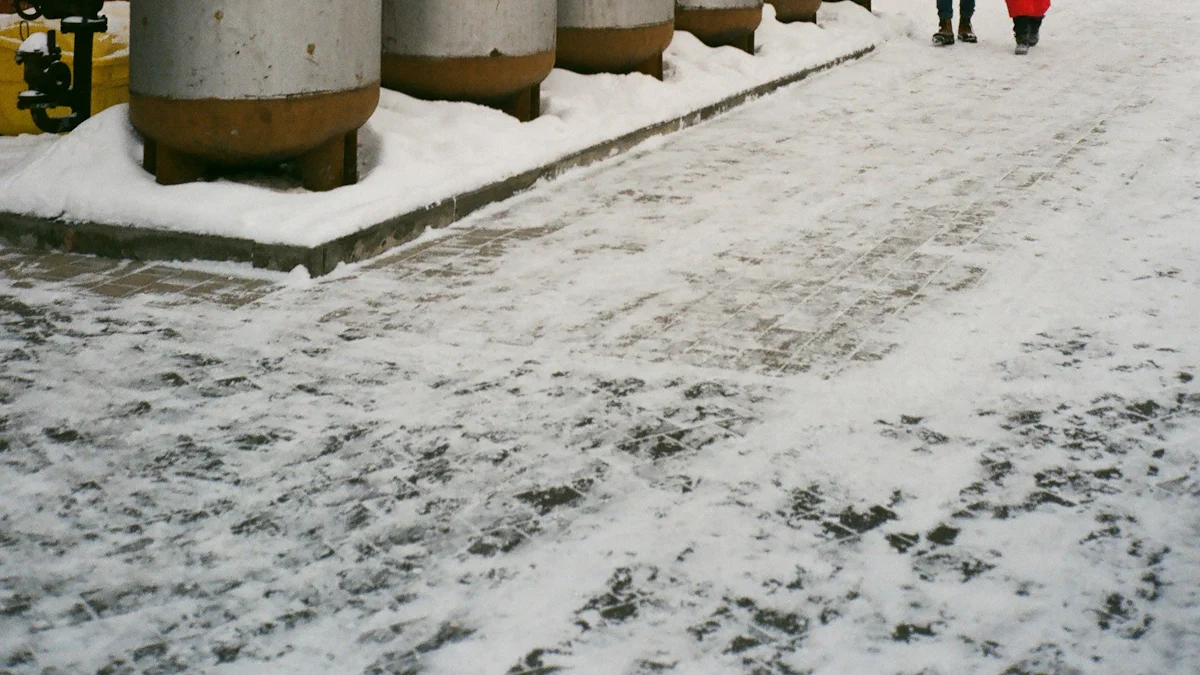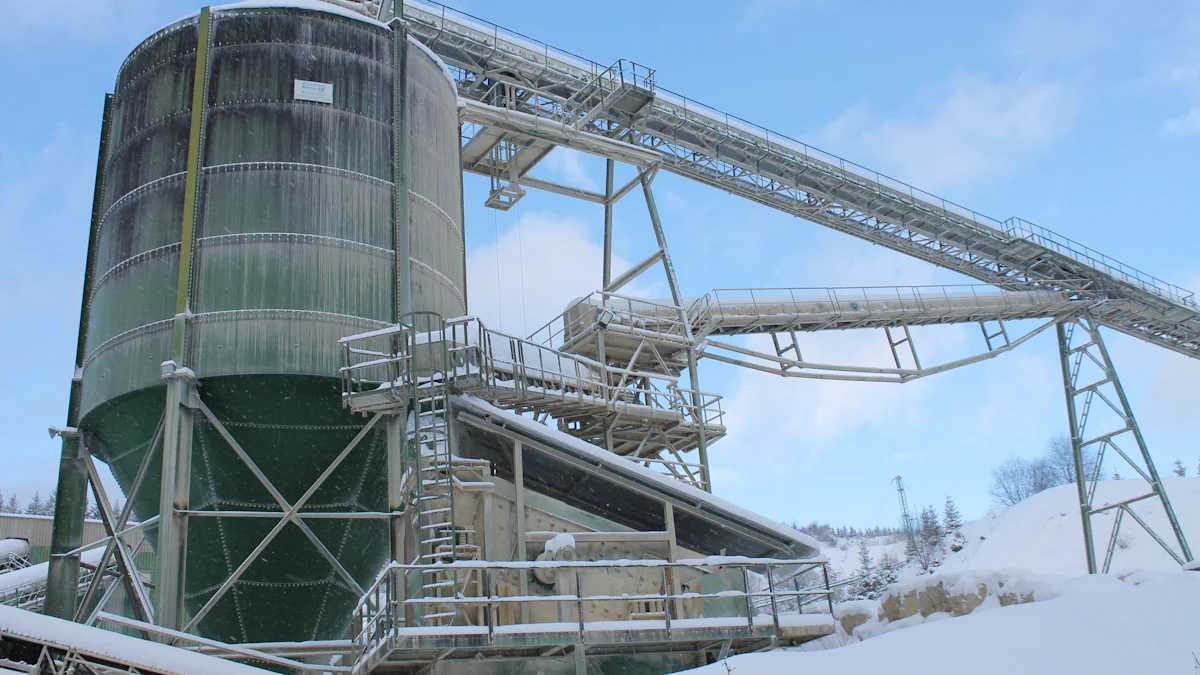Understanding Blast Freezing and Its Process in 2025

Blast freezing is a rapid freezing method that locks in the quality of products by quickly lowering their temperature. This process prevents the formation of large ice crystals, which can damage texture and flavor. You’ll find this technique essential in industries where preserving freshness and safety is critical. For example, the blast freezer market is growing rapidly, with its value expected to reach USD 3.16 billion by 2030. This growth reflects its increasing adoption in food service, healthcare, and logistics, where maintaining product integrity is a top priority.
Key Takeaways
Blast freezing quickly cools food to keep it fresh. It stops big ice crystals that can ruin taste and texture.
This process keeps food safe by stopping bacteria and slowing spoilage. It helps food last longer on shelves.
New blast freezers save energy and use eco-friendly coolants. They work well and are better for the environment.
Businesses like restaurants and hospitals use blast freezing. It protects food and medical items that spoil easily.
In 2025, new tech like IoT makes blast freezing better. It helps monitor and control the process more easily.
What Is Blast Freezing?
Definition and Key Features
Blast freezing is a method that rapidly cools products to extremely low temperatures. This freezing process slows down biochemical reactions that cause spoilage. It also prevents microbial growth, ensuring food safety. Unlike traditional freezing, blast freezing creates smaller ice crystals. These tiny crystals preserve the cellular structure of food, maintaining its texture, flavor, and nutritional value. You’ll notice that this method extends shelf life while keeping the product’s quality intact. Industries like food service and healthcare rely on this technique to maintain high standards.
How It Differs from Traditional Freezing
Blast freezing stands out because of its speed and efficiency. Traditional freezers take hours to freeze products, forming large ice crystals that damage food structure. In contrast, a blast freezer can freeze the same product in just 30 minutes. This rapid cooling preserves food quality and reduces bacterial growth. Additionally, blast freezers use high-speed cold air, which minimizes moisture loss and maintains flavor. They are also more energy-efficient, handling larger quantities with less energy per kilogram. For example:
A traditional freezer takes about 6 hours to freeze a product.
A blast freezer completes the task in 30 minutes.
This efficiency makes blast freezing ideal for industries that need to process large volumes quickly.
Role of Blast Freezers in the Process
Blast freezers play a crucial role in the blast freezing process. They precisely control temperature and airflow to prevent thermal shock and dehydration. This ensures that food retains its quality and nutritional value. By rapidly cooling products, blast freezers slow down spoilage and inhibit microbial growth. They also minimize the formation of large ice crystals, preserving the texture and flavor of food. Whether you’re in catering or logistics, these freezers ensure the safety and integrity of frozen products until they reach the consumer.
How Does Blast Freezing Work?

The Science Behind Blast Freezing
Rapid Temperature Reduction
Blast freezing works by rapidly lowering the temperature of food to preserve its quality. This quick cooling slows down biochemical processes that cause spoilage. It also inhibits microbial growth by disrupting their metabolism. When you use this method, enzymatic activity that leads to undesirable changes in food is halted. The rapid temperature drop ensures that food remains fresh and safe for longer periods.
Prevention of Ice Crystal Formation
One of the key benefits of blast freezing is the prevention of large ice crystal formation. Smaller ice crystals form during the process, which protects the cellular structure of food. This means that when you thaw the food, it retains its original texture and flavor. By reducing damage during freezing and thawing, this method ensures that the food you freeze maintains its quality.
Equipment Used in Blast Freezing
Blast Freezers and Their Components
Blast freezers are the backbone of the blast freezing process. These machines operate at temperatures ranging from -10 °C to -120 °C, with most industrial units set between -30 °C and -40 °C. They circulate extremely cold air to freeze food quickly, reducing freezing times to as little as 30 minutes for smaller items. Blast freezers maintain precise air temperatures, typically between -30 °C and -65 °C, depending on the product's requirements. This precision ensures effective preservation and extends the shelf life of frozen goods.
Energy Efficiency in Modern Systems
Modern blast freezers are designed with energy efficiency in mind. Improved insulation and advanced refrigeration systems reduce energy consumption. Many units now feature IoT technology, allowing you to monitor and control freezing processes with precision. Modular designs make these systems customizable to meet specific needs, while eco-friendly refrigerants and heat recovery systems contribute to sustainability. These advancements not only save energy but also enhance the overall efficiency of the freezing process.
Benefits of Blast Freezing
Food Quality Preservation
Retention of Texture and Flavor
Blast freezing ensures that food retains its original texture and flavor. The process exposes food to extremely cold air, forming small ice crystals that protect the cellular structure. This prevents damage that often occurs during slower freezing methods. For example:
Smaller ice crystals preserve the food’s texture, making it feel fresh when thawed.
Rapid freezing slows spoilage, maintaining the food’s natural taste.
By minimizing large ice crystal formation, you can enjoy food that tastes as good as it did before freezing.
Maintenance of Nutritional Value
Blast freezing also preserves the nutritional value of food. The rapid cooling rate minimizes oxidative damage, keeping vitamins and minerals intact. Foods frozen this way experience less drip loss during thawing, which helps retain essential nutrients. For instance:
Benefit | Explanation |
|---|---|
Rapid Cooling Rate | Prevents ice crystal formation, preserving cell structure. |
Minimal Drip Loss | Retains nutrients and flavors during thawing. |
Better Nutrient Retention | Maintains vitamins and minerals, ensuring high-quality food. |
This method extends shelf life without compromising the food’s nutritional quality.
Enhanced Food Safety
Prevention of Bacterial Growth
Blast freezing enhances food safety by preventing bacterial growth. The rapid temperature drop inhibits microorganisms from reproducing. It also halts enzymatic activity that causes spoilage. For example:
Freezing at temperatures as low as -184°F stops bacteria from thriving.
Smaller ice crystals maintain cellular integrity, reducing contamination risks.
This ensures that frozen food remains safe for consumption, minimizing the risk of foodborne illnesses.
Operational Efficiency
Faster Freezing Times
Blast freezing achieves faster freezing times compared to traditional methods. This efficiency helps you process large quantities of food quickly. Rapid cooling also preserves the food’s quality by maintaining its texture and flavor. For example:
Faster freezing delays spoilage, extending the product’s shelf life.
Quick freezing reduces the risk of contamination during the cook chill process.
Reduced Waste and Spoilage
By slowing spoilage, blast freezing reduces waste in food industries. The process prevents crystallization, which can lead to loss of freshness. It also inhibits microbial growth, ensuring longer storage periods. For instance:
Rapid cooling halts enzymatic reactions that degrade food.
Smaller ice crystals preserve cellular structures, reducing thawing damage.
This method helps you maintain food quality while minimizing waste.
Applications of Blast Freezing Across Industries

Food Service and Manufacturing
Freezing Perishable Goods
Blast freezing plays a vital role in preserving perishable goods in the food service and manufacturing sectors. By rapidly lowering the temperature of food, this method minimizes the risk of cellular damage. It ensures that the texture, flavor, and nutritional value of food remain intact. For instance, cafeterias and restaurants use blast freezing to quickly freeze prepared meals, preventing bacterial growth and maintaining food safety. This process is especially critical in the frozen food industry, where quality at defrost is essential for customer satisfaction.
Prevents spoilage by halting enzymatic activity.
Reduces contamination risks during the cook chill process.
Meeting Regulatory Standards
Meeting health and safety regulations is a top priority in food manufacturing. Blast freezing helps you achieve this by rapidly cooling food products to inhibit microbial growth. This process ensures compliance with stringent food safety standards and reduces the risk of foodborne illnesses. By controlling harmful bacteria, you can deliver safe and high-quality products to consumers.
Rapid cooling slows spoilage and ensures safe storage.
Inhibits bacteria, keeping food compliant with health regulations.
Healthcare and Pharmaceuticals
Preservation of Medical Supplies
In healthcare and pharmaceuticals, blast freezing ensures the stability and efficacy of sensitive materials. It maintains precise temperatures for storing vaccines, blood samples, and other medical supplies. This rapid cooling prevents degradation, preserving the chemical and biological properties of these items. For example, vaccines require consistent low temperatures to remain effective. Blast freezing provides the reliability needed for safe storage and transport in this critical industry.
Maintains the integrity of sensitive drugs and vaccines.
Prevents degradation of medical supplies, ensuring effective treatment.
Logistics and Cold Chain Management
Ensuring Product Integrity During Transport
Blast freezing is essential for maintaining product integrity during transport. It rapidly lowers the temperature of food products, preserving their nutritional value, texture, and flavor. This method also inhibits microbial growth and enzymatic reactions, extending shelf life. Proper management of temperature and airflow in blast freezers prevents thermal shock and dehydration, ensuring frozen products remain indistinguishable from fresh ones upon thawing.
Protects food quality during transit.
Reduces spoilage, ensuring safety for consumers.
Extends shelf life, making storage and transport more efficient.
Technological Advancements in Blast Freezing in 2025
Innovations in Blast Freezer Design
Energy-Efficient Models
Modern blast freezers prioritize energy efficiency to reduce operational costs and environmental impact. Improved insulation and advanced refrigeration systems minimize energy loss. Variable speed drives and high-efficiency compressors optimize performance while consuming less power. These innovations ensure that you can freeze products quickly without compromising quality. Additionally, energy-efficient models often include heat recovery systems, which repurpose waste heat for other processes, further enhancing efficiency.
Compact and Scalable Systems
Blast freezer designs in 2025 focus on flexibility and adaptability. Compact models save space, making them ideal for smaller facilities. Scalable systems allow you to expand capacity as your needs grow. Modular designs also enable customization, ensuring the freezer meets specific requirements. Whether you manage a small kitchen or a large manufacturing plant, these systems provide tailored solutions for efficient blast chilling and storage.
Integration of Smart Technology
IoT and Automation in Freezing Processes
Smart technology transforms how you manage blast freezing. IoT-enabled systems provide real-time data analytics, helping you monitor temperature and airflow with precision. Predictive maintenance features alert you to potential issues before they cause downtime. Remote control capabilities let you adjust settings from anywhere, ensuring consistent performance. Integration with warehouse management systems streamlines operations, improving inventory tracking and storage efficiency. These advancements make blast chilling more reliable and user-friendly.
Sustainability in Blast Freezing
Use of Eco-Friendly Refrigerants
The shift to eco-friendly refrigerants addresses environmental concerns. Modern blast chillers use alternatives with lower global warming potential, reducing greenhouse gas emissions. These refrigerants maintain high performance while aligning with sustainability goals. By adopting these systems, you contribute to a greener future without sacrificing freezing efficiency.
Reduction in Carbon Footprint
Advancements in blast freezing technology help you lower your carbon footprint. Energy-efficient models reduce power consumption through features like variable speed drives and optimized compressors. Scheduling operations during off-peak hours further minimizes energy use. These strategies not only cut costs but also support sustainable practices. The combination of eco-friendly refrigerants and energy management systems ensures that your blast freezing operations remain environmentally responsible.
Blast freezing offers you a reliable way to preserve food quality and safety. It works by rapidly lowering temperatures, preventing bacterial growth, and maintaining the texture, flavor, and nutrients of products. This process extends shelf life and reduces waste, making it essential for industries like food service, healthcare, and logistics.
Blast freezing effectively stops the decline in nutrients in its tracks, preserving the delicate nutrients in food.
The benefits of blast freezing include:
Drastically reducing bacterial growth and contamination.
Extending the shelf life of food products.
Preserving the products’ textures and flavors.
Technological advancements in 2025 further enhance its efficiency and sustainability. Energy-efficient designs, IoT-enabled systems, and eco-friendly refrigerants reduce environmental impact while improving operational flexibility. These innovations ensure that you can freeze products faster, safer, and more sustainably than ever before.
By adopting blast freezing, you not only protect product integrity but also contribute to a greener future.
FAQ
What is the ideal temperature range for blast freezing?
Blast freezing typically operates between -30°F and -40°F. This range ensures rapid cooling, which prevents large ice crystals from forming. Some systems can go as low as -120°F for specific applications, like preserving medical supplies.
How does blast freezing differ from flash freezing?
Blast freezing uses high-speed cold air to freeze products quickly, while flash freezing involves submerging items in liquid nitrogen or carbon dioxide. Blast freezing is more common in food industries, whereas flash freezing is often used for specialty applications.
Can you use blast freezing for non-food items?
Yes, blast freezing works for non-food items like medical supplies, vaccines, and biological samples. It ensures these items remain stable by maintaining their chemical and biological properties during storage and transport.
How long does it take to freeze food in a blast freezer?
The freezing time depends on the product's size and type. Smaller items can freeze in as little as 30 minutes, while larger items may take up to 90 minutes. This speed helps preserve quality and safety.
Is blast freezing environmentally friendly?
Modern blast freezers use energy-efficient designs and eco-friendly refrigerants. These features reduce energy consumption and greenhouse gas emissions, making them a sustainable choice for freezing processes.
Tip: Look for models with energy certifications to ensure your blast freezer aligns with sustainability goals.
See Also
Maximizing Food Preservation With Blast Freezer Technology
Exploring The Benefits Of Fluidized Monomer Freezing
The Advantages Of Using A Blast Freezer For Seafood

